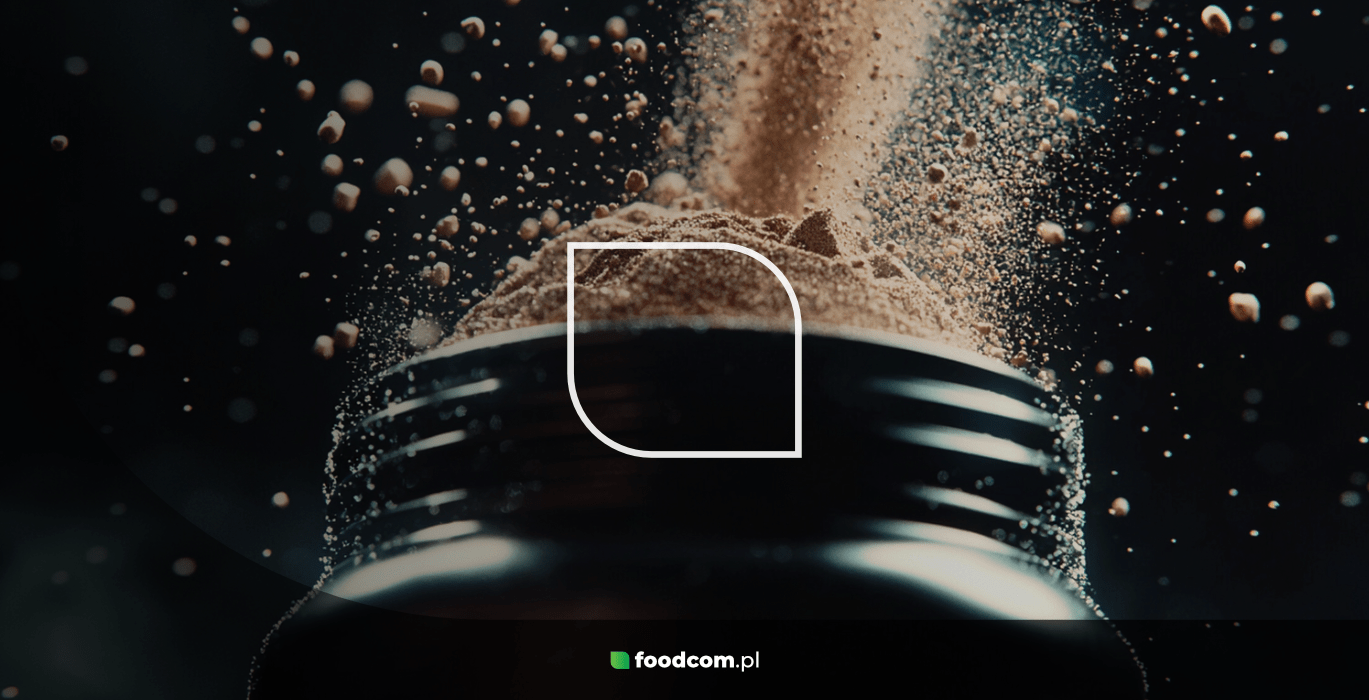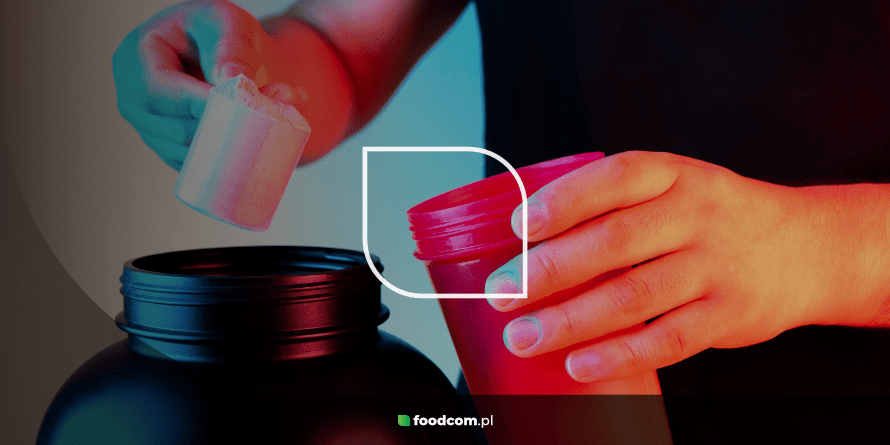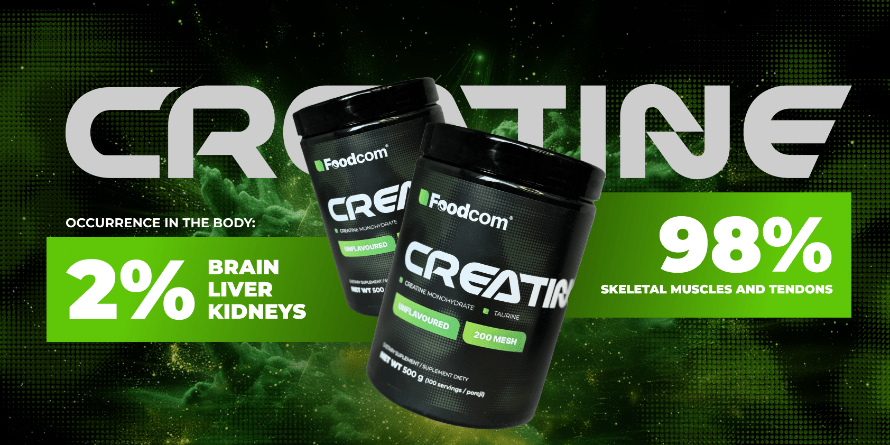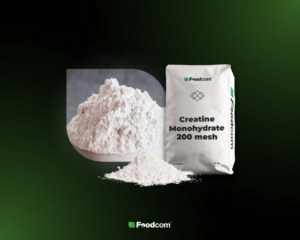- Creatine is a natural compound with proven ergogenic effects that is increasingly found in supplements, functional foods, and specialty products.
- Creatine monohydrate is the most popular form on the market.
- The global creatine market exceeded $1.5 billion in 2024, with forecasts reaching $2.6 billion by 2029.
- Creatine is used not only by athletes, but also in supplements for women, the elderly, patients requiring clinical nutrition, and in the feed industry.
Creatine is a compound that occurs naturally in the body of humans and other animals. It plays an important role in the energy processes of the body’s cells. It is often used by athletes and bodybuilders due to the fact that it supports the formation of muscle proteins. However, more and more is also being said about its other uses. Let’s find out what creatine gives, how it works, the types of creatine and the situation on the creatine market.
What is creatine?
Creatine, or β-methylguanidinoacetic acid, is an organic nitrogenous compound which occurs naturally in the bodies of humans and animals – especially in their muscles (98%), but also in the brain, liver or kidneys. It is synthesised from amino acids (arginine, glycine and methionine) in the liver, pancreas and kidneys. Its primary function is to provide a rapid source of cellular energy for tissues with high energy requirements – primarily skeletal muscle and the brain.
Natural sources of creatine in the diet are red meat and fish, but the average intake of these foods does not cover the full metabolic capacity of the body – which is why creatine supplementation is so common. Due to its high stability, good solubility and proven health benefits, creatine can be used in the formulations of many food products and dietary supplements.
What does creatine do? Mechanism of action
The action of creatine is based on its role in the energy metabolism of cells. When the body needs energy immediately – for example during exercise – it uses a compound called ATP. The problem is that ATP supplies are very limited and are depleted within seconds. Phosphocreatine, formed from creatine, acts as an energy buffer – it gives up its phosphate group to ADP, enabling the rapid synthesis of more ATP.
Now that we know how creatine works, we can answer the question – what is creatinine used for? Supplementation with this substance results in:
- increased muscular strength and power (improves strength, endurance and speed),
- improved tolerance to intensive exercise (by up to 10-15%),
- faster recovery after exercise (reduces muscle acidification, aids recovery),
- better progress in building muscle mass,
- in slimmers, an elimination of the effect of muscle mass loss,
- improved brain function, especially in situations of energy deficit (sleepiness, stress, ageing).
Thanks to its effects, creatine has recently gained the attention of not only athletes, but also clinical nutritionists, therapeutic food manufacturers and doctors, especially neurologists.
Types of creatine and their applications
The classic form of creatine is creatine monohydrate, but other variants are now appearing on the market. It is creatine monohydrate, however, that remains the best studied, well absorbed, purest type of this substance. It contains up to 90% pure creatine combined with 10% water, which accounts for its excellent purity. It also provides pronounced muscle growth. Due to its versatility, it is the most widely used form of creatine for industrial applications.
Creatine malate is another common form. This compound is formed from a combination of malic acid and three creatine molecules. The substance is stable, is quickly absorbed, dissolves better in water, and causes less stomach discomfort and does not lead to excess water retention in the body, as can happen with monohydrates.
The forms of creatine described and other types encountered are discussed and compared in the table below:
| Type of creatine | Characteristics |
|---|---|
| Creatine monohydrate | Well studied, stable, pure form of creatine; high durability, versatility and bioavailability |
| Creatine malate (TCM) | Newer, stable, well soluble in water; less gastric problems and water storage |
| Creatine hydrochloride (HCL) | Concentrated, well absorbed, high strength and muscle gains without significant weight gain |
| Kre-alkaline | Buffered form of creatine, similar to monohydrate but gentler on the stomach and does not cause water storage in the body |
| Creatine pyruvate/creatine citrate | Stable, well absorbed, significant effect on the regeneration process |
| Creatine magnesium chelate | Magnesium-enhanced creatine action to increase bioavailability and endurance |
| Creatine ethyl (CEE) | Increases transport across cell membranes, does not need glucose for transport, but is less stable |
| Creatine nitrate | Less effect on muscles, more effect on vasodilation |
| Alphacetoglutarate | Salt of glutaric acid and creatine, well absorbed and effectively saturates muscles |
Which creatine to choose?
When choosing creatine, it is worth taking into account what kind of results you want to achieve, as well as your body’s individual predisposition – whether it is gaining strength and muscle mass, water storage or the sensitivity of your digestive system. Some recommend trying different types of creatine and changing them frequently. A factor that many people also take into account is the price of the different types of creatine.
Creatine comes in various commercial forms such as:
- creatine powder for dissolution,
- capsules and tablets,
- shakes and drinks with added creatine,
- jellies and functional bars.
How do I use creatine?
Creatine should be taken with high-carbohydrate and low-fat meals (e.g. dissolved in juice), which improves its absorption. Its absorption is also improved by whey protein concentrates (WPC) and whey protein isolates (WPI), and reduced by alcohol. Its action may also be supported by other supplements: magnesium, BCAA amino acids, lecithin or alpha-lipoic acid.
To notice the effects, creatine must be taken regularly over several weeks. Should I take creatine every day? Yes, it should be taken every day, whether on training days or not.
And how do you dose creatine? There are different approaches to this subject. One is to use high doses of creatine in the initial period (the so-called loading/saturating phase) and then lower the dose to the standard 3-5g (maintenance phase). Alternatively, a fixed dose can be used – usually 3-5 g or 1 g per 10 kg of body weight. However, choosing the right dose is an individual issue that should be discussed with a personal trainer or nutritionist and your doctor.
Creatine in industry
The use of creatine in industry covers several main areas:
- the production of dietary supplements – in powder and capsule form, as well as in shots, bars and jellies with added creatine, and pre- and post-workout preparations;
- functional foods – protein products, e.g. high-protein yoghurts, puddings, bars, milk drinks, isotonic drinks with added creatine, products with added collagen and adaptogens (e.g. aimed at women, the elderly or young people);
- medical dietetics – high-protein preparations in clinical nutrition for convalescents and the elderly, as well as for neurological patients (Parkinson, SLA);
- feed industry – creatine is a valued feed additive for promoting weight gain and metabolic efficiency (mainly in piglets and broilers), thus improving feed conversion and contributing to a shorter breeding cycle.
In industrial applications, creatine monohydrate remains the most important. It is the oldest, most reliable, proven and purest form of creatine with a good value for money.
We can distinguish between several types of creatine monohydrate, such as 200 mesh or 80 mesh creatine monohydrate. These have different functional properties. The 200 mesh form is a very finely ground powder with excellent solubility and purity of over 99%, mainly used for premium products (e.g. creatine capsules). Creatine monohydrate 80 mesh is less finely ground, has a lower price and better flowability, and is therefore used in various mixtures and protein supplements, as well as in animal nutrition.
Is creatine safe? Safety of supplementation
Organisations such as EFSA (European Food Safety Authority), ADA (American Dietetic Association) or ISSN (International Society for Sports Nutrition) classify creatine as a supplement with high safety and efficacy in supporting exercise. Creatine is very well tolerated and studied (particularly with regard to creatine monohydrate), with no documented toxic effects
The human requirement for creatine is approximately 7 g per day, however, our body only produces approximately 1 g of creatine. The rest of this compound must be supplied externally – from the diet and from possible supplementation. If you stick to the individual dosage rules agreed with your doctor or nutritionist, it is difficult to overdose on creatine. However, mild side effects may occur, such as water retention in the body, bloating or gastrointestinal discomfort. To avoid these, it is advisable to stay hydrated and drink about 20-25% more fluids when taking this supplement.
Keep in mind that each body may react differently to creatine, so it is worth discussing supplementation with your doctor. A specialist may also order tests for electrolytes, glucose and lipids, as well as liver and kidney tests – contraindications to creatine use include failure of these organs. It should also not be taken if you have pancreatic disease, bipolar affective disorder, are pregnant or lactating, or are under 18 years of age.
The creatine market: data, trends and forecasts
According to 2024 data, the global creatine market is worth USD 1.5 billion, of which approximately 70% is creatine monohydrate. The forecast for the current year 2025 is USD 1.68 billion, and by 2029 the creatine market is expected to grow to USD 2.61 billion. The average annual growth rate is 11-12%.
Trends in the market are moving towards creatine supplements aimed at different groups. Supplements for seniors are expected to improve bone and brain health and memory, while supplements for young adults involved in sports are expected to improve performance. There is a significant increase in creatine sales among women, with 320% more sales in the first quarter of 2025 than last year.
Creatine is now one of the most valuable functional ingredients in the nutrition industry. Its effects are no longer limited to supporting athletes – there is a growing sector of creatine used to improve health and brain performance, as well as aimed at various social groups.
Bibliography:
- Buford, T. W. et al. (2007): Creatine supplementation and exercise performance: recent findings. Sports Medicine.
- EFSA (2004): Scientific Opinion on the safety of creatine monohydrate for use in foods for particular nutritional uses. EFSA Journal 2004, 36:1-6
- Grand View Research: Creatine Supplement Market Size, Share & Trends Analysis Report (2024-2030)
- Kreider, R. B. et al. (2017): International Society of Sports Nutrition Position Stand: safety and efficacy of creatine supplementation in exercise, sport, and medicine. Journal of the International Society of Sports Nutrition
- Stout, J. R., Antonio, J., Kalman, D. (eds) (2008): Essentials of Creatine in Sports and Health. Humana Press, New Jersey
- Volek, J. S., Rawson, E.S. (2004): Scientific basis and practical aspects of creatine supplementation for athletes. Nutrition, 20(7-8):609-614











